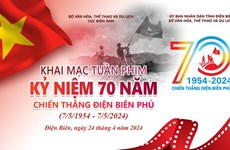Understanding 'Mo' through recreating house-cooling ritual of Muong ethnic people
On the occasion of Vietnam Ethnic Culture Day (April 19), the house-cooling ritual of Muong and Hoa Binh ethnic people was re-enacted at the Vietnamese Ethnic Culture Village in Dong Mo of Hanoi.
This was a chance for the public to know more about “Mo Muong”, a cultural heritage that has been submitted to UNESCO for recognition as an intangible cultural heritage of the world.
"Mo Muong" is the word used to refer to a shaman in Muong’s culture. The house-cooling ritual is one of 23 traditional rituals of the Muong people.
In the verses and vows, the shaman would tell the story of the Muong people; how gods divided heaven and earth; how everything, like time, good and evil, and many other things, were born; how shamans were chosen by gods.
Those stories reflected the worldview, life experience, knowledge, and spiritual life of the Muong people.
The Muong has five mo tunes, known in the local language as "Ò hoi," "Dà đôông," "Dà dê," "Hâm mo" and "Hệu kệu”. These tunes were used to ask for luck for newborn babies, to exorcise evil spirits, heath for sick people, happiness for weddings…
The shaman's tools include a bag of smoke and a book of whips. Among them, there are bronze and stone knives, passed down through generations in the family. The book of whips actually is bamboo sticks engraved with auspicious days and months for a whole year.
At the end of the ritual, the shaman would ask for names, then cast a spell and tied a red thread around the wrists of participants. This was a form of praying for luck, health, and harmonious life.
Finally, the shaman would sprinkle water, chanted mantras to cool the furniture in the house, and prayed for peace for the house’s owner.
The festival part began right after the ritual part. Everyone would sing and enjoy rice wine together. By doing so, they finished a meaningful and equally solemn rendition of the Muong ethnic identity./.













